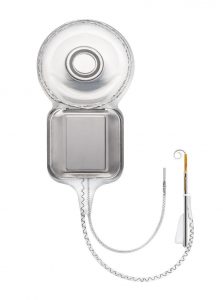By Wade Colburn, Product Manager, Cochlear Implants at Cochlear Americas
For 19 years, Cochlear has innovated with the intent of making perimodiolar electrodes thinner, less traumatic and closer to the hearing nerve, with the ultimate goal of improving hearing performance for cochlear implant recipients.1
While measuring the proximity of an electrode to the modiolus is not an easy or common surgical practice, certain university-based research groups have been able to use 3D CT reconstructions to make the calculation. These centers then use this information to determine correlations between hearing performance outcomes and electrode proximity. One of the groups, Washington University in St Louis, has developed a way to measure array position and describes the calculation as “Wrapping Factor”.2
What is Wrapping Factor?
As defined in Holden et al2, Wrapping Factor provides a metric of how tightly or loosely wrapped an electrode array is relative to the modiolus. A high Wrapping Factor closer to 100% would mean that the array is close to the lateral wall, while a smaller number indicates the array is wrapped more tightly relative to the modiolus. Historically, as previously reported by Holden et al, a perimodiolar electrode would be expected to have a value around 60%, while a lateral wall electrode may have a value closer to 80%.
Why does Wrapping Factor matter?
Evidence suggests that cochlear implant electrode arrays placed with a closer proximity to the modiolus are associated with improved speech performance. In Holden et al, the recipients with the best hearing performance were implanted with arrays shown to have wrapping factors near 60%, suggesting there may be a benefit to close modiolar placement2. Historically, an electrode placed closer to the nerve has been associated with focused stimulation3 and reduced channel interaction4. Close proximity to the modiolus has also demonstrated more stable impedances and lower current levels4. Evidence suggests that if the stimulation can be focused and close to the nerve, there is a potential to see improved performance3,5.
In a recent multicenter study on the Cochlear™ Nucleus® Slim Modiolar Electrode (CI532), out of 82 reconstructions with scala tympani placement, the mean wrapping factor was 59.6%5. This demonstrates the Wrapping Factor for CI532 is consistent with what was shown in Holden et al, and also confirms the placement of CI532 is routinely placed closer to the nerve. A temporal bone study further showed that with CI532, the electrode contacts are consistently closer to the hearing nerve when compared to previous observations of other electrodes6.
To learn more about Wrapping Factor and the Cochlear Nucleus Slim Modiolar Electrode (CI532), review our latest brochure or visit our website for more information.
Wade Colburn is the Product Manager for the Cochlear Implant product portfolio within Cochlear Americas. Wade’s responsibilities include product positioning and messaging, life-cycle management, new product launches and surgical support and training. Wade joined Cochlear with an engineering background within the medical device field, including previous otology experience.
© Cochlear Limited 2019. All rights reserved. Hear now. And always and other trademarks and registered trademarks are the property of Cochlear Limited or Cochlear Bone Anchored Solutions AB. The names of actual companies and products mentioned herein may be the trademarks of their respective owners.
Please seek advice from your health professional about treatments for hearing loss. Outcomes may vary, and your health professional will advise you about the factors which could affect your outcome. Always read the instructions for use. Not all products are available in all countries. Please contact your local Cochlear representative for product information. Views expressed are those of the individual. Consult your health professional to determine if you are a candidate for Cochlear technology.
References:
- Risi F. Considerations and Rationale for Cochlear Implant Electrode Design – Past, Present and Future. J Int Adv Otol 2018; 14 (3): 382-91.
- Holden LK, Finley CC, Firszt JB, Holden TA, Brenner C, Potts LG, et al. Factors affecting open-set word recognition in adults with cochlear implants. Ear Hear. 2013; 34(3):342-60
- Polonenko et al. Stimulation parameters differ between current anti-modiolar and peri-modiolar electrode arrays implanted within the same child. The Journal of Laryngology & Otology. 2016; 130(11):1007-1021.
- DeVries, L, et al. Assessing the Electrode-Neuron Interface with the Electrically Evoked Compound Action Potential, Electrode Position, and Behavioral Thresholds. JARO. 2016; 17(3):237-52.
- Preliminary Data on File: US Multicenter CI532 Study. 2018.
- EA32 Electrode Insertion Safety and Performance Study Report. Data on File (Document Number: 473386)





